Premium Only Content

Why the Panama Canal is Dying
It's a long queue that could have repercussions on our daily lives. For the past few weeks, hundreds of container ships have been clogging up in front of one of the essential links in international trade. The Panama Canal, a gigantic corridor some 80 kilometers long, has been taken over by merchant ships. They are all waiting to cross this 100-year-old passage linking the Atlantic and Pacific Oceans. Some 14,000 ships use it every year, accounting for 6% of the world's merchandise flow. A vital link in the supply chain to stores all over the world, but one that's set to continue...
Technical failure, lack of space, climate issues... why is this marvel of engineering, with its eventful history, now under threat? Back in 2006, the queues in Panama were already making headlines. The canal had become too dilapidated, too small to accommodate the new container ships, ever larger, ever wider and ever bigger. After a referendum vote, the country embarked on a 6 billion euro expansion of the canal. In 2016, the new canal opened its locks and was able to accommodate 95% of the world's ships. Lake Gatun has also been transformed. Its bed was deepened by 45 cm. This work was intended to allow more boats to pass through every day.
Despite expectations, this pharaonic project has not solved the water shortage problem. In the face of drought, Panama seems helpless. For the time being, the first response has been to confirm the restrictions on passages for the coming year, if the rains are not sufficient until November, the end of the country's rainy season.
The authorities are aware that action needs to be taken: "From the point of view of the volume of water required by the Panama Canal, another source of supply is necessary", said Canal Administrator Ricaurte Vásquez in mid-September.
At a press conference, he unveiled an outline of the solution. The creation of a new water reservoir to the west of the canal. This would be made up of water from the Indio River. This reservoir would feed the main artificial lake, Lake Gatún, via an 8-kilometre underground water pipeline. This new source of supply will have to be built up first, and this is likely to take some time. According to estimates, it will take around three months if rainfall is abundant, and almost 2.5 years if drought persists. Another potential project announced by the company involves extracting the precious liquid from Lake Bayano, located to the west of the Canal, and then pouring it into the sea passage. These new developments still need to be consolidated, approved and financed before they can see the light of day.
-
 LIVE
LIVE
Bannons War Room
4 months agoWarRoom Live
9,974 watching -
 2:38:44
2:38:44
The Charlie Kirk Show
4 hours agoLIVE: US Bombs Iran - Trump Speaking Soon
316K375 -
 58:11
58:11
Right Side Broadcasting Network
4 hours agoLIVE: President Trump Addresses the Nation Following U.S. Attack on Iran's Nuclear Sites - 6/21/25
284K189 -
 58:44
58:44
The White House
4 hours agoPresident Trump Delivers Address to the Nation, June 21, 2025
154K254 -
 LIVE
LIVE
NEWSMAX
6 months agoNEWSMAX2 LIVE | Real News for Real People
1,454 watching -
 LIVE
LIVE
KLW World News
5 hours agoBREAKING NEWS! US BOMBS 3 NUKE SITES IN IRAN!
1,467 watching -
 1:45:46
1:45:46
BlackDiamondGunsandGear
3 hours agoAFTER HOURS ARMORY / USA Dropping Bombs / Mike w - Krate Tactical / DLD After Dark
17.4K2 -
 1:45:46
1:45:46
DLDAfterDark
2 hours ago $4.02 earnedThe United States Strikes Iran With Multiple Bunker Buster Missles - Is This The Start of WWIII?
31.1K7 -
 1:03:29
1:03:29
Hard Lens Media
5 hours ago $5.82 earnedTRUMP Addressing The Nation As He Announced US Bombed Three Iranian Nuclear Sites
71.4K32 -
 16:46
16:46
Exploring With Nug
14 hours ago $8.54 earnedWe Recovered a Stolen Chevy Malibu From the River! Underwater Vehicle Search!
149K10